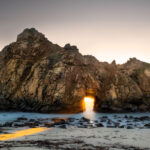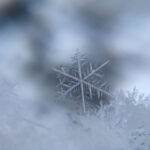Most people think of glaciers as being brightly white and—because most surface-level glaciers are made from airy, unpacked snow—this is largely true. However, some majestic glaciers and icebergs appear to be blue, ranging from powdery sky blues to deep ocean blues, such as in this photo of an enormous iceberg that rolled over as it became top-heavy, revealing its dark blue underbelly:
This deep blue color is the result of two phenomena: light and pressure.
Like water, snow and ice absorb red and yellow light and only allow blue light to filter through them. Beneath the snowy exterior of glaciers is a vibrant blue wonderland, since lower layers of ice are under more compacting pressure than upper layers. The same is true of the underbellies of icebergs—the upper, exposed layers of ice retain a powdery blue exterior as they brave the winds, but the underbelly is pressured by the sea, resulting in much darker hues.
Rolling is not uncommon for icebergs. After an iceberg detaches from a glacier to float solo, warmer ocean currents melt the submerged layers, resulting in one top-heavy block of ice. To maintain its center of gravity and stay afloat, the iceberg ‘flips.’ This is rarely caught on film, but one lucky tourist in Argentina captured the stunning event from his catamaran:
Like This Article?
Don't Miss The Next One!
Join over 100,000 photographers of all experience levels who receive our free photography tips and articles to stay current:







Hi
Many thanks for sharing the articles on your website.
I am confused by the description of warmer air temperature causing the iceberg to roll over. I would have thought that woman a temperature would reduce the upper part of the iceberg making it more stable.
I had assumed that it was the warmest sea temperature melting the underside of the iceberg causing the iceberg to roll over as it became top-heavy?
All the best
Peter
Thanks for catching that! :)